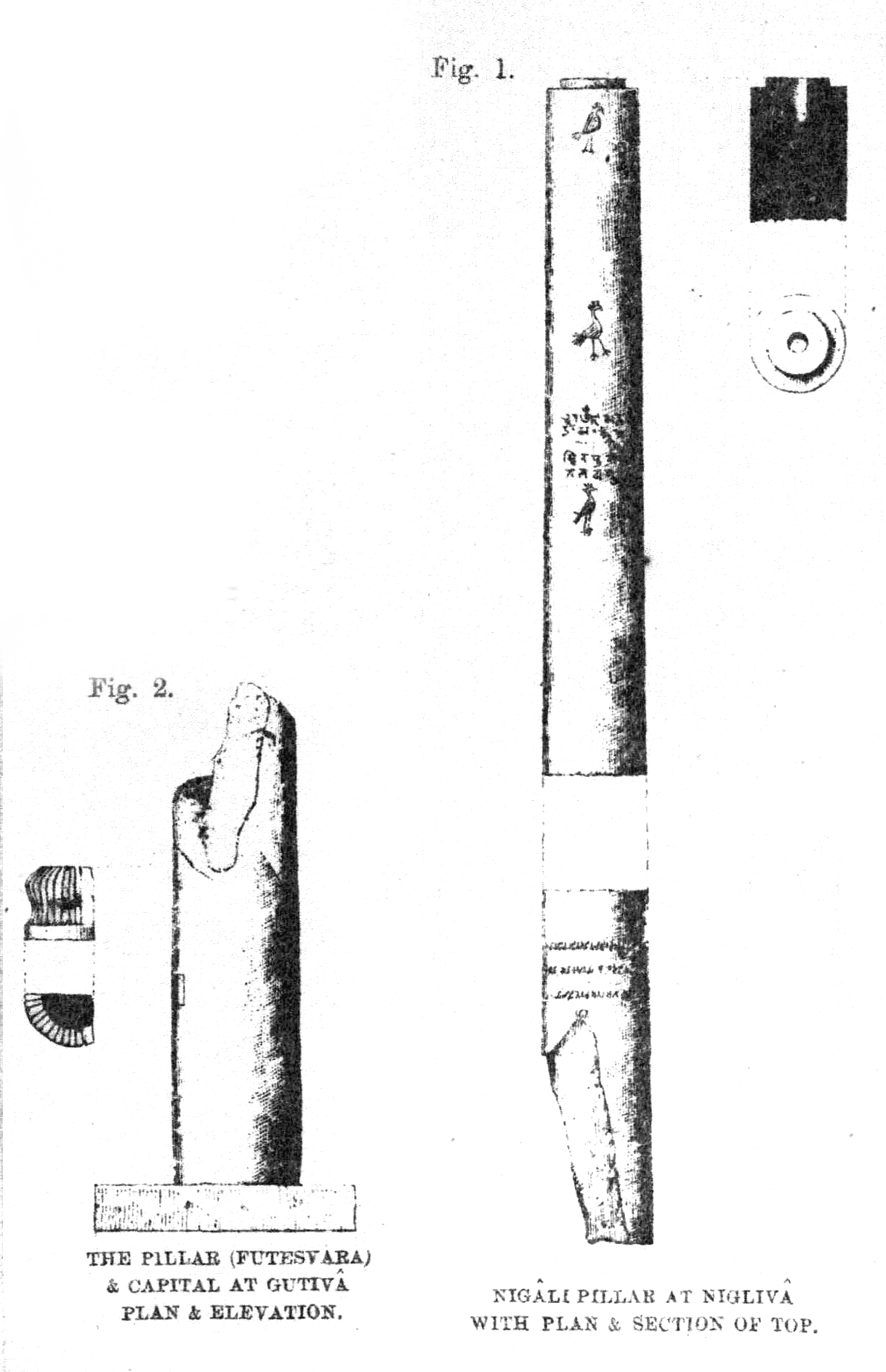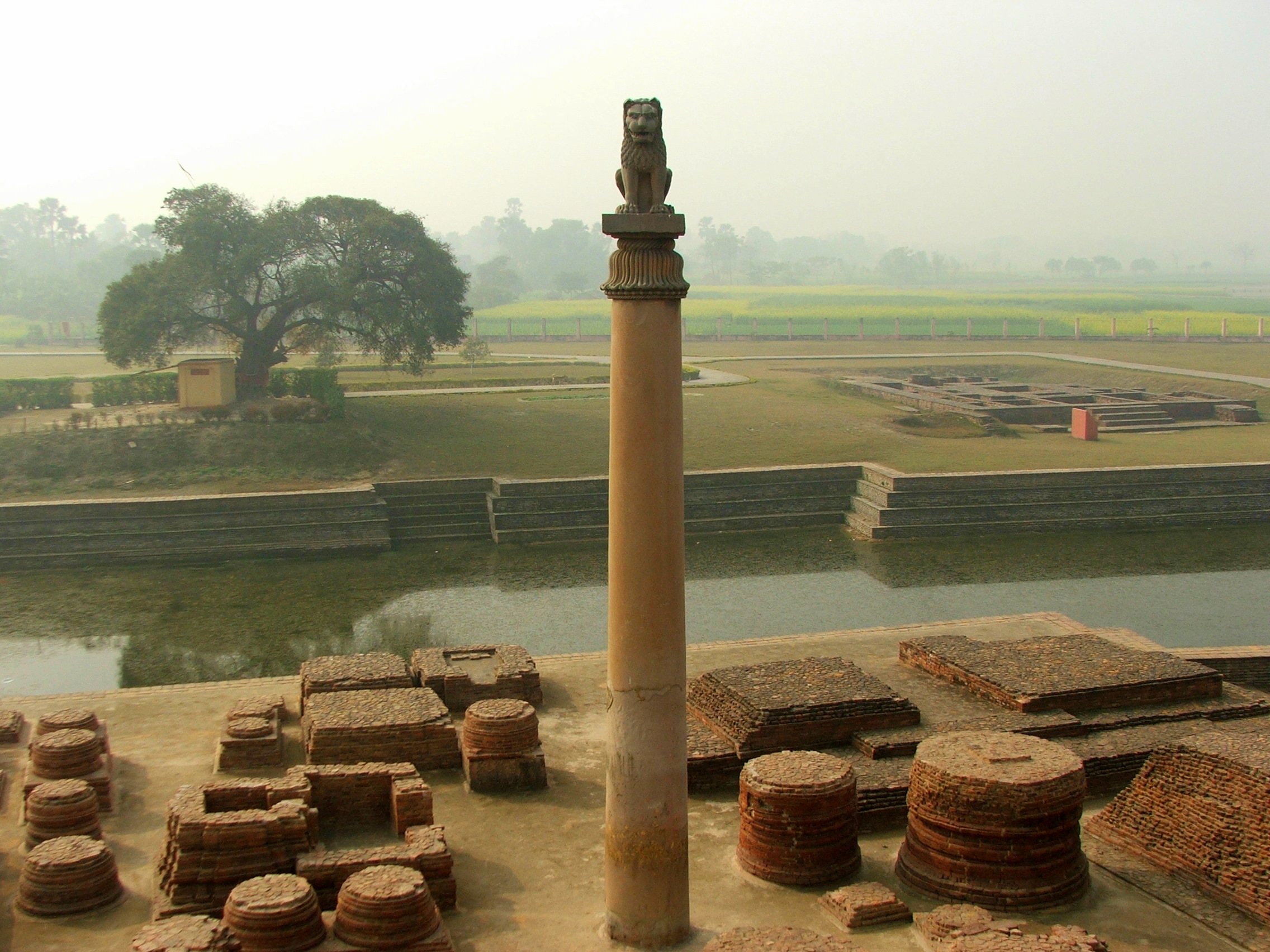|
Gotihawa
Gotihawa (formerly called Gutivā in Western sources) is a village development committee located about southeast of Kapilavastu, in Kapilvastu District, in the Lumbini Zone of southern Nepal. At the time of the 1991 Nepal census it had a population of 3,335 people living in 567 individual households. History Modern-day Gotihawa was known as Khemavati in ancient times. According to Theravāda Buddhist tradition, Kakusandha Buddha was born in Khemavati. Kakusandha Buddha is one of the ancient Buddhas whose biography is chronicled in chapter 22 of the '' Buddhavamsa'', one of the books of the Pāli Canon. The base of a Pillar of Ashoka has been discovered at Gotihawa, and it has been suggested that it is the original base of the Nigali Sagar pillar fragments, found a few miles away, which contain an inscription of Ashoka Ashoka (, ; also ''Asoka''; 304 – 232 BCE), popularly known as Ashoka the Great, was the third emperor of the Maurya Empire of Indian subco ... [...More Info...] [...Related Items...] OR: [Wikipedia] [Google] [Baidu] |
Nigali Sagar
Nigali Sagar (also called Nigliva, Nigali Sagar pillar, Nighihawa pillar, Nigliva pillar, or Araurakot pillar) is an archaeological site in Nepal containing the remains of a pillar of Ashoka. The site is located in Nigalihawa, about 20 kilometers northwest of Lumbini and 7 kilometers northeast of Taulihawa Kapilvastu (also known by name of Taulihawa) is a municipality and administrative center of Kapilvastu District in Lumbini Province of southern Nepal. The municipality is located roughly to the south-west of Lumbini, a UNESCO World Heritage Si .... Another famous inscription discovered nearby in a similar context is the Lumbini pillar inscription. Discovery The pillar was discovered in 1893 by a Nepalese officer on a hunting expedition. The pillar and its inscriptions (there are several inscriptions on it, from Brahmi to Medieval) were researched in March 1895 by Alois Anton Führer. Führer published his discovery in the ''Progress Report of the Archaeological Survey Circle ... [...More Info...] [...Related Items...] OR: [Wikipedia] [Google] [Baidu] |
Kapilvastu Municipality
Kapilvastu (also known by name of Taulihawa) is a municipality and administrative center of Kapilvastu District in Lumbini Province of southern Nepal. The municipality is located roughly to the south-west of Lumbini, a UNESCO World Heritage Site and the birthplace of Gautama Buddha. Kapilvastu Municipality was established in 1982 with the name of Taulihawa Nagarpanchayat merging Baragdawa, Maalpara, Pipari, Kapilvastu Adarsh Gaau and some portion of Tilaurakot, Gotihawa and Gobari Gaunpanchayat. Later on 7 November 2014 remaining region of Gotihawa and Tilaurakot VDC were included making total 19 wards within this Municipality. On March 10, 2017, the Government of Nepal restructured the local level bodies into 753 new local level structures. The previous Taulihawa Municipality with Dharampaniya, Dohani, Jahadi, Nigalihawa and Sauraha VDCs were merged to form Kapilvastu Municipality. Now total area of the municipality is and total population is 76,394. The municipality ... [...More Info...] [...Related Items...] OR: [Wikipedia] [Google] [Baidu] |
Pillar Of Ashoka
The pillars of Ashoka are a series of monolithic columns dispersed throughout the Indian subcontinent, erected or at least inscribed with edicts by the Mauryan Emperor Ashoka during his reign from c. 268 to 232 BCE. Ashoka used the expression ''Dhaṃma thaṃbhā'' (Dharma stambha), i.e. "pillars of the Dharma" to describe his own pillars. These pillars constitute important monuments of the architecture of India, most of them exhibiting the characteristic Mauryan polish. Of the pillars erected by Ashoka, twenty still survive including those with inscriptions of his edicts. Only a few with animal capitals survive of which seven complete specimens are known. Two pillars were relocated by Firuz Shah Tughlaq to Delhi. Several pillars were relocated later by Mughal Empire rulers, the animal capitals being removed.Krishnaswamy, 697-698 Averaging between in height, and weighing up to 50 tons each, the pillars were dragged, sometimes hundreds of miles, to where they were erected. ... [...More Info...] [...Related Items...] OR: [Wikipedia] [Google] [Baidu] |
Kakusandha Buddha
Kakusandha (Pāli), or Krakucchaṃda in Sanskrit, is one of the ancient Buddhas whose biography is chronicled in chapter 22 of the ''Buddhavaṃsa'', one of the books of the Pali Canon. According to Theravāda Buddhist tradition, Kakusandha is the twenty-fifth of the twenty-nine named Buddhas, the fourth of the Seven Buddhas of Antiquity, and the first of the five Buddhas of the present kalpa. The present kalpa is called the ''bhadrakalpa'' (Auspicious aeon). The five Buddhas of the present kalpa are: #Kakusandha (the first Buddha of the bhadrakalpa) # Koṇāgamana (the second Buddha of the bhadrakalpa) # Kassapa (the third Buddha of the bhadrakalpa) #Gautama (the fourth and present Buddha of the bhadrakalpa) #Maitreya (the fifth and future Buddha of the bhadrakalpa) Life Kakusandha was born in Khemavati Park in Khemavati according to the Theravada tradition. Khemavati is now known as Gotihawa, and it is located about southeast of Kapilavastu, in Kapilvastu District, in the ... [...More Info...] [...Related Items...] OR: [Wikipedia] [Google] [Baidu] |
Village Development Committee (Nepal)
A village development committee ( ne, गाउँ विकास समिति; ''gāum̐ vikās samiti'') in Nepal was the lower administrative part of its Ministry of Federal Affairs and Local Development. Each district had several VDCs, similar to municipalities but with greater public-government interaction and administration. There were 3,157 village development committees in Nepal. Each village development committee was further divided into several wards ( ne, वडा) depending on the population of the district, the average being nine wards. Purpose The purpose of village development committees is to organise village people structurally at a local level and creating a partnership between the community and the public sector for improved service delivery system. A village development committee has status as an autonomous institution and authority for interacting with the more centralised institutions of governance in Nepal. In doing so, the village development co ... [...More Info...] [...Related Items...] OR: [Wikipedia] [Google] [Baidu] |
Populated Places In Kapilvastu District
Population typically refers to the number of people in a single area, whether it be a city or town, region, country, continent, or the world. Governments typically quantify the size of the resident population within their jurisdiction using a census, a process of collecting, analysing, compiling, and publishing data regarding a population. Perspectives of various disciplines Social sciences In sociology and population geography, population refers to a group of human beings with some predefined criterion in common, such as location, race, ethnicity, nationality, or religion. Demography is a social science which entails the statistical study of populations. Ecology In ecology, a population is a group of organisms of the same species who inhabit the same particular geographical area and are capable of interbreeding. The area of a sexual population is the area where inter-breeding is possible between any pair within the area and more probable than cross-breeding with ind ... [...More Info...] [...Related Items...] OR: [Wikipedia] [Google] [Baidu] |
Fragments Of Gotihawa And Nigali Sagar
Fragment may refer to: Entertainment Television and film * "Fragments" (''Torchwood''), an episode from the BBC TV series * "Fragments", an episode from the Canadian TV series ''Sanctuary'' * "Fragments" (Steven Universe Future), an episode from the American TV series ''Steven Universe Future'' * ''Fragments'' (film) (a.k.a. ''Winged Creatures''), a 2009 film * '' Fragments: Chronicle of a Vanishing'', a 1991 Croatian film Music * "Fragments" (song), a song by Jack Johnson * "Fragments", a song from ''Endless Wire'' (The Who album) * ''Fragments'' (Paul Bley album), a 1987 album by jazz pianist Paul Bley * ''Fragments'', an album by the Danish singer Jakob Sveistrup * ''Fragments'' (EP), an EP by Rapids! * ''Fragments'', an EP by Chipzel * ''Fragments'' (Bonobo album), a 2022 album by British producer Bonobo Other * ''Fragments'', a play by Edward Albee * ''Fragments: Memories of a Wartime Childhood 1939–1948'', a fictional memoir of Holocaust survival by Binjamin W ... [...More Info...] [...Related Items...] OR: [Wikipedia] [Google] [Baidu] |
Ashoka
Ashoka (, ; also ''Asoka''; 304 – 232 BCE), popularly known as Ashoka the Great, was the third emperor of the Maurya Empire of Indian subcontinent during to 232 BCE. His empire covered a large part of the Indian subcontinent, stretching from present-day Afghanistan in the west to present-day Bangladesh in the east, with its capital at Pataliputra. A patron of Buddhism, he is credited with playing an important role in the spread of Buddhism across ancient Asia. Much of the information about Ashoka comes from his Brahmi edicts, which are among the earliest long inscriptions of ancient India, and the Buddhist legends written centuries after his death. Ashoka was son of Bindusara, and a grandson of the dynasty's founder Chandragupta. During his father's reign, he served as the governor of Ujjain in central India. According to some Buddhist legends, he also suppressed a revolt in Takshashila as a prince, and after his father's death, killed his brothers to ascend ... [...More Info...] [...Related Items...] OR: [Wikipedia] [Google] [Baidu] |
Pāli Canon
The Pāli Canon is the standard collection of scriptures in the Theravada Buddhist tradition, as preserved in the Pāli language. It is the most complete extant early Buddhist canon. It derives mainly from the Tamrashatiya school. During the First Buddhist Council, three months after the parinibbana of Gautama Buddha in Rajgir, Ananda recited the Sutta Pitaka, and Upali recited the Vinaya Pitaka. The Arhats present accepted the recitations and henceforth the teachings were preserved orally by the Sangha. The Tipitaka that was transmitted to Sri Lanka during the reign of King Asoka were initially preserved orally and were later written down on palm leaves during the Fourth Buddhist Council in 29 BCE, approximately 454 years after the death of Gautama Buddha. The claim that the texts were "spoken by the Buddha", is meant in this non-literal sense. The existence of the bhanaka tradition existing until later periods, along with other sources, shows that oral tradition conti ... [...More Info...] [...Related Items...] OR: [Wikipedia] [Google] [Baidu] |
Buddhahood
In Buddhism, Buddha (; Pali, Sanskrit: 𑀩𑀼𑀤𑁆𑀥, बुद्ध), "awakened one", is a title for those who are awake, and have attained nirvana and Buddhahood through their own efforts and insight, without a teacher to point out the dharma (Sanskrit 𑀥𑀭𑁆𑀫; Pali ''dhamma''; "right way of living"). The title is most commonly used for Gautama Buddha, the founder of Buddhism, who is often simply known as "the Buddha". Buddhahood ( sa, 𑀩𑀼𑀤𑁆𑀥𑀢𑁆𑀯, buddhatva; pi, buddhatta or ; ) is the condition and rank of a buddha "awakened one". This highest spiritual state of being is also termed ''sammā-sambodhi'' (skt. samyaksaṃbodhi 'full complete awakening'). The title is also used for other beings who have achieved ''bodhi'' (awakening) and ''moksha'' (release from craving), such as the other human Buddhas who achieved enlightenment before Gautama, the five celestial Buddhas worshiped primarily in Mahayana, and the bodhisattva named M ... [...More Info...] [...Related Items...] OR: [Wikipedia] [Google] [Baidu] |
Theravada
''Theravāda'' () ( si, ථේරවාදය, my, ထေရဝါဒ, th, เถรวาท, km, ថេរវាទ, lo, ເຖຣະວາດ, pi, , ) is the most commonly accepted name of Buddhism's oldest existing school. The school's adherents, termed Theravādins, have preserved their version of Gautama Buddha's teaching or ''Dharma (Buddhism), Buddha Dhamma'' in the Pāli Canon for over two millennia. The Pāli Canon is the most complete Buddhist canon surviving in a Indo-Aryan languages, classical Indian language, Pali, Pāli, which serves as the school's sacred language and ''lingua franca''.Crosby, Kate (2013), ''Theravada Buddhism: Continuity, Diversity, and Identity'', p. 2. In contrast to ''Mahāyāna'' and ''Vajrayāna'', Theravāda tends to be conservative in matters of doctrine (''pariyatti'') and monastic discipline (''vinaya''). One element of this conservatism is the fact that Theravāda rejects the authenticity of the Mahayana sutras (which appeared c. ... [...More Info...] [...Related Items...] OR: [Wikipedia] [Google] [Baidu] |






.jpeg/1200px-Gandhara_Buddha_(tnm).jpeg)
